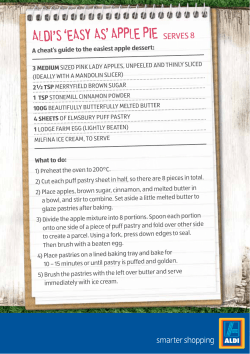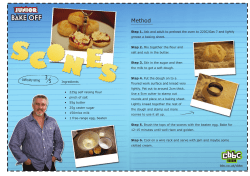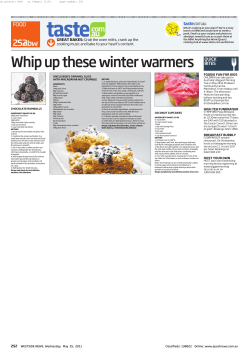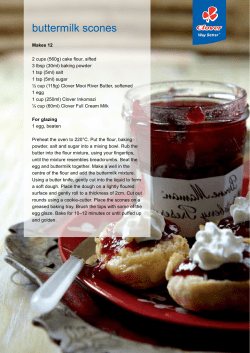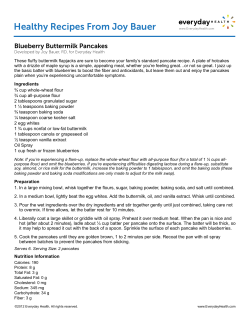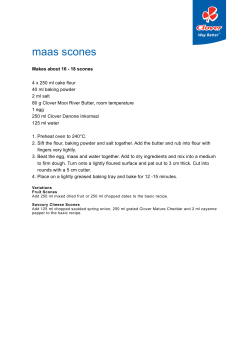
O Biscuits, Cornbread, Muffins and Cream Puffs
A G O O D C O O K I S A L W A Y S L E A R N I N G ™ Biscuits, Cornbread, Muffins and Cream Puffs Easy Baked Goods You Can Produce in Your Kitchen BY CHEF JOE ABUSO O ne way to set your restaurant apart from the competition is to serve your guests freshly baked goods made from scratch. This is something that any customer will notice and love, and will keep them coming back for more. From muffins at breakfast, cornbread for lunch and dinner, biscuits any time of day and cream puff-based items for dessert, these items can always be added to your kitchen’s repertoire. Although some baked items require quite a bit of skills and experience that might be beyond the scope of your staff, others can be handled by any cook with just a little training and practice. Rising Controversy One aspect of producing baked goods that is inherently intimidating to some cooks is the fact that these products are leavened. But the processes involved are not magic or rocket science and are really pretty simple. The word leavened comes from an Indo-European root meaning, “light,” as in not heavy. It is through the proper use of various leaveners that the baker achieves the desired texture of his or her products. Whether that desired texture is a very light and airy sponge cake, chewy sourdough bread, flaky biscuits, even flakier puff pastry, light but rich profiteroles, fairly dense and rich cornbread or even denser and richer carrot cake, a correctly employed leavening agent played its role. If you have any confusion about just what leavening is about, think of “unleavened bread,” aka 44 | matzo bread. Leaveners do their job by introducing carbon dioxide gas or steam into batters and doughs, which, when cooked, lessens the amount of solid matter as compared with air in the final product. This results in a less dense, tenderer and lighter offering at the table. For an example of the opposite effect, once again, consider the matzo. One of the main ways we can succeed in producing great baked goods in-house, without a pastry chef or baker handy, is to carefully consider which leavening agents to use, and which to avoid. There are three basic types of leaveners: organic, physical and chemical. The organic leaveners are yeasts and sourdough starters, which are living organisms. While organic leaveners produce some of the greatest items ever to come out of any kitchen (French baguettes, pizza and brioche, for example) they can be a little tricky to work with and take some practice. This is not to say it’s impossible to crank out great products using these leaveners; people do it every day and have done it for many years. But it’s not the easiest, most sure-fire way to get fresh-baked goods into your dining room. In the second type of leavening, “physical,” the steam that is produced as the liquids in a dough or batter are heated during the cooking process is the leavening agent, which creates air pockets that are then baked into the structure of the item. Steamleavened products include sponge cakes, soufflés, puff pastry and croissants. Although steam leav- GOOD RESTA 4U 4 R A| T E UGROSOADR R E EASLTW AU AR YA S TLEEUARRSN A I NRGE A L W A Y S L E A R N I N G ening plays a part in all leavened products, those that rely totally on steam to achieve their texture are also not the path of least resistance for a cook with little experience in baking. That leaves us with items that are made with chemical leaveners as our primary menu items of choice. The main chemical leaveners are baking soda and baking powder. In both cases, an alkaline ingredient reacts with an acid, resulting in the production of a gas, carbon dioxide. This carbon dioxide forms bubbles in the batter or dough which expand during baking, resulting in the desired, “leavened” texture. When using baking soda, the baking soda itself is the alkaline ingredient, which reacts with acidic ingredients in the recipe, such as sour cream, buttermilk or chocolate. Baking powder contains both the alkaline and acid components of the equation: baking soda for the alkaline, and cream of tartar for the acid. Double-acting baking powders work in two ways. First, the two ingredients react with each other when combined with a liquid. Then they react again when exposed to heat. The carbon dioxide that these products produce is the same gas produced when using yeast, but the chemical leaveners produce the gas much more quickly and require much less expertise on the part of the baker. Fresh biscuits, hot out of the oven, are always a treat. Whether presented in a breadbasket at breakfast with some nice jam or honey, smothered in sausage-cream gravy or served with compound sweet potato butter with a pecan-crusted chicken breast for dinner, your guests will appreciate the effort. This recipe produces a very moist, flaky biscuit. Buttermilk Biscuits Yield: About 40 1 1/2-inch biscuits All-purpose flour................................ 3.5 cups Salt................................................ 1 teaspoon Double-acting baking powder.....4 teaspoons Baking soda................................... 1 teaspoon Sugar...........................................2 teaspoons Unsalted butter, frozen....................10 ounces Buttermilk........................................1 1/2 cups Measurement Besides overcoming “leavening anxiety,” which can be alleviated by sticking mostly with recipes that use baking powder, nonbaking cooks also must carefully measure the ingredients to recipes for baked goods. While it’s no problem in a lot of situations in a kitchen to just “eyeball” what goes into a pot, that technique won’t fly when baking. Be sure to measure each ingredient accurately, whether by volume or weight. This is called “scaling.” After the dry ingredients are scaled, they should be sifted. This will remove any lumps, aerate and more evenly distribute the various ingredients. A good way to do this is to sift the ingredients onto a sheet of parchment paper, and then use the paper to transfer the ingredients to the mixing bowl. It’s a good idea to scale out all of a recipe’s ingredients before starting to actually make it. Also be sure to follow the procedure in the recipe carefully. If it says to not overmix, don’t overmix (if you’re not sure, err on the side of undermixing). If it says the butter should be frozen, use frozen butter. If it says to preheat the oven, preheat the oven. If it specifies pastry flour, well, you get the idea. Scale out, and then sift together the dry ingredients. Cut the butter into sweet pea-sized cubes and, using a pastry blender, cut the butter into the dry ingredients. Don’t overdo it; it should look like course cornmeal, with plenty of lumps of butter. Mix in the buttermilk, all at once, quickly and briefly, less than half a minute, total. Knead the dough gently on a floured board, again for no more than half a minute. You AUGUST 2010 | w w w . RJeUsLtYa u2r0a 1n0t O |w nwew r .w c o. Rme s t a u r4a5n t O w n e r . c o m 45 don’t want the butter to melt very much. Roll out the dough with a lightly floured rolling pin to about a half-inch thick. Cut out circles with a 1 1/2-inch cutter, but don’t twist it. Lightly brush the top with more buttermilk, and bake immediately on a greased cookie sheet in a preheated 450-degree-Fahrenheit oven for about 10 minutes, until golden brown on top and bottom. Alternately, after the biscuits are cut out but before they’re brushed with buttermilk, they can be refrigerated and baked as needed. Cornbread is especially good when it’s baked in cast-iron molds that have been preheated in a hot oven, and then sprayed with nonstick spray just before they are filled with the batter and baked. You’ll end up with beautifully browned, crunchy cornbread, in whatever shape you’ve chosen for the molds. Once you have mastered the following basic cornbread recipe, which is as easy as baking gets, feel free to experiment with incorporating various garnishes into the batter to suit your needs. Try adding sautéed diced onion and jalapeños, with or without the seeds, depending on how spicy you think your guests will like it. Another variation is to first roast whole, shucked ears of fresh corn in a hot oven till golden brown, then cut off the kernels and add those. Add diced, crispy bacon, substituting some of the bacon grease for the butter in the recipe. Adding small-diced cheddar cheese will probably be popular, if only because they’ll make people think about what homemade Cheetos® might be like. Even if one of your ideas doesn’t quite pan out, it will still probably be a good item for a family meal, and it’s not like any of the ingredients in the basic recipe are all that expensive. Cornbread Yield: About 2 1/2 quarts of batter Coarse ground cornmeal.......................3 cups All-purpose flour....................................3 cups Double-acting baking powder...3 tablespoons Salt............................................2 tablespoons Whole milk.............................................3 cups Melted unsalted butter...................... 3 ounces Large eggs, lightly beaten.....................6 each Scale out, and then sift together the dry ingredients. Stir in the milk, butter and eggs. Heat the cast-iron molds in a 400-degree oven until very hot, spray with release spray, and fill 46 | with batter to about three-fourths full. Bake in a 400-degree oven for 15-20 minutes, depending on the molds used. It should be golden brown and puffy. Made-from-scratch muffins are easy to make, and will absolutely put you in a different league from any establishment that serves thawed-out, or almost thawed-out, frozen options. The basic recipe given here will teach you the technique to make any variety. Feel free to add to this recipe as the spirit or season moves you. Blueberry. Date. Fig. Walnut. Cinnamon-apple. Banana. Cranberry-orange-ginger. The options are limitless. The batter can be made in advance and stored, covered and refrigerated for a couple of days. Basic Muffins Yield: 6 dozen Unsalted butter, at room temperature......................... 1 pound Sugar.............................. 1 pound + 3 ounces Salt................................................. 3/4 ounce Eggs, large...........................................11 each Bread flour................................. 2 1/2 pounds Baking powder..................................2 ounces Whole milk........................................... 1 quart In a mixer, mix together the butter, sugar and salt, using the paddle attachment. It should be smooth, creamy and light. This is known as “creaming” the ingredients. Don’t rush this step. Scrape down the sides of the bowl with a rubber spatula as you go to make sure all of it is incorporated. Always shut off the mixer while scraping down the sides. Add the eggs gradually, with the mixer on medium speed. After the eggs are totally incorporated, continue to mix for two more minutes, scraping the bowl as needed. Add GOOD RESTA 4U 6 R A| T E UGROSOADR R E EASLTW AU AR YA S TLEEUARRSN A I NRGE A L W A Y S L E A R N I N G the remaining ingredients with the mixer on low speed, then increase to medium speed for another two minutes. Fill greased muffin pans about two-thirds full and bake in a preheated 425-degree F oven for 15-20 minutes, or until golden brown on top. Pâte à Choux is the name for the dense batter that bakes into the delicate, hollow shells we call cream puffs, éclairs and profiteroles. Unlike the previous recipes, which all use baking powder as their leavening agent, pâte à choux (aka cream puff pastry) relies on the steam produced from the liquids in the batter to create one of the lightest baked products around. It’s a little trickier than cornbread to make at first, but with some practice, it becomes easy. It’s very versatile, and can be used for savory, as well as sweet menu items. Filled with pastry cream, they make the classic éclair, with ice cream, a type of profiterole. But if made miniature and filled with salmon mousse, they make a great hors d’oeuvre. Pâte à Choux Yield: 1 1/2 pounds dough Water......................................................1 pint Unsalted butter................................. 4 ounces Salt............................................. 1/2 teaspoon Bread flour.................................. 9 1/2 ounces Eggs............................... 1 pint, approximately In a pot, combine the water, butter and salt. Over high heat, bring to a rolling boil. Add the flour and, over medium heat, stir constantly until the mixture forms a ball and pulls away from the side of the pot. Transfer to a mixer with the paddle attachment and mix at medium speed until it cools slightly. (You don’t want the mixture to be hot enough to cook the eggs during the next step.) Slowly add the eggs in several batches. You want to add as much of the eggs as you can, without the paste becoming too loose to hold its shape when you pipe it onto parchment in the next step. It should be shiny and medium-firm. The dough should now be used immediately. Fill a pastry bag with a plain tip and pipe out the desired shape onto a parchment-lined sheet pan — long for éclairs, round for profiteroles and cream puffs. Place in a preheated 425-degree oven, and bake until they just begin to brown. Then lower the oven to 325 F and bake until golden brown. As long as it doesn’t get too brown, you can’t overcook pâte à choux. Let cool at room temperature. They can be stored, covered at room temperature for up to a couple of days before being slit on the sides with a sharp knife and filled. Once they’re filled, serve as soon as possible. AUGUST 2010 | w w w . RJeUsLtYa u2r0a 1n0t O |w nwew r .w c o. Rme s t a u r4a7n t O w n e r . c o m 47
© Copyright 2025
